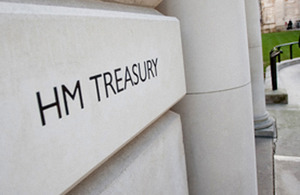Update to 2020-21 government financing remit
Following the publication of the Office for Budget Responsibility’s (OBR’s) Economic and Fiscal Outlook (EFO), the UK Debt Management Office’s (DMO’s) 2020-21 financing remit has been revised.

This follows on from the last revision to the DMO’s financing remit for 2020-21, published on 16 July 2020, which laid out planned gilt sales of £385 billion up to end-November 2020. This update sets out plans for the remainder of 2020-21.
The financing arithmetic sets out the components of the government’s net financing requirement (NFR) and the contributions from various sources of financing. The updated financing arithmetic for 2020-21 is set out in Table 1.
The OBR’s forecast for the central government net cash requirement (excluding NRAM plc, Bradford and Bingley and Network Rail) (CGNCR (ex NRAM, B&B and NR)) in 2020-21 is £402.5 billion. This is the fiscal aggregate that determines gross debt sales and is derived from the Public Sector Net Borrowing (PSNB) forecast. The net financing requirement for the DMO in 2020-21 is £483.5 billion.
Planned gilt sales for the DMO will total £485.5 billion in 2020-21 and will be split by maturity and type as follows:
- £167.9 billion of short conventional gilts (34.6% of total issuance)
- £149.6 billion of medium conventional gilts (30.8% of total issuance)
- £134.9 billion of long conventional gilts (27.8% of total issuance)
- £33.2 billion of index-linked gilts (6.8% of total issuance)
HMT is also confirming today that NS&I’s net financing target for 2020-21 remains unchanged at £35 billion (+/-£5 billion). On 16 July 2020, this target was revised upwards from £6 billion (+/- £3 billion) to reflect the government’s increased funding requirements during the COVID-19 pandemic.
The funds raised from retail savers by NS&I are an important source of government financing. In the first six months of this financial year, NS&I raised £38.3 billion. With gilt yields currently at low levels, however, the government can currently raise finance more cost-effectively through gilt issuance.
Table 1: Financing arithmetic in 2020-21 (£ billion)
| Budget 2020 | November 2020 | |
|---|---|---|
| CGNCR (ex NRAM, B&B and NR)(1) | 65.3 | 402.5 |
| Gilt redemptions | 97.6 | 97.6 |
| Planned financing for the Official Reserves | 0.0 | 0.0 |
| Financing adjustment carried forward from previous financial years(2) | -0.8 | 18.4 |
| Gross Financing Requirement | 162.1 | 518.5 |
| Less: | ||
| NS&I net financing | 6.0 | 35.0 |
| Other financing items(3) | 0.0 | 0.0 |
| Net Financing Requirement (NFR) for the DMO | 156.1 | 483.5 |
| DMO’s NFR will be financed through: | ||
| Gilt sales, through sales of: | ||
| - Short conventional gilts | 51.0 | 167.9 |
| - Medium conventional gilts | 34.2 | 149.6 |
| - Long conventional gilts | 42.3 | 134.9 |
| - Index-linked gilts | 20.6 | 33.2 |
| - Unallocated amount of gilts | 8.0 | 0.0 |
| Total gilt sales for debt financing | 156.1 | 485.5 |
| Total net contribution of Treasury bills for debt financing | 0.0 | -2.0 |
| Total financing | 156.1 | 483.5 |
| DMO net cash position | 0.5 | 0.5 |
| Figures may not sum due to rounding |
(1) Central Government Net Cash Requirement (excluding NRAM plc, Bradford and Bingley (B&B) and Network Rail (NR)).
(2) The £18.4 billion financing adjustment in 2020-21 carried forward from previous years reflects the 2019-20 outturn for CGNCR ex, as first published on 23 April 2020.
(3) Prior to the publication of the end-year outturn in April each year, this financing item will mainly comprise estimated revenue from coinage.
Further information
1) The relationship between PSNB and the CGNCR (ex NRAM, B&B and NR) is set out in paragraph 4.191 of the OBR’s October 2018 EFO.
2) Additional details of the revised financing programme, including the DMO’s planned operations calendar for January to March 2021, are set out in the DMO’s financing remit announcement, as published on its website today.
3) The DMO has raised £393.6 billion via gilt sales in 2020-21 to date.
4) HMT and the UK Statistics Authority (UKSA) have today also published the outcome of their joint consultation on reform to the Retail Prices Index methodology.
5) Further information can be found at: